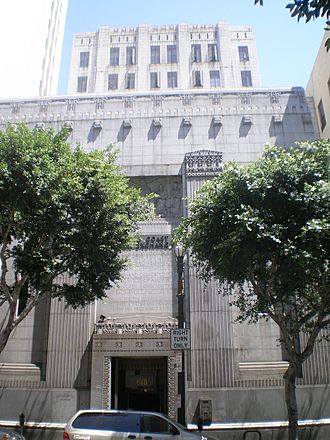Los Angeles Stock Exchange Building facts for kids
The Los Angeles Stock Exchange Building is a famous old building in Downtown Los Angeles. It's also known as the Pacific Stock Exchange Building. For many years, from 1931 to 1986, it was the main office for important stock exchanges like the Los Angeles Stock Exchange. Later, it became home to popular nightclubs.
This building is so special that it was named a Los Angeles Historic-Cultural Monument in 1979. This means its unique look is protected, so it can't be changed easily.
Quick facts for kids Los Angeles Stock Exchange Building |
|
|---|---|
 |
|
| Alternative names | Pacific Coast Stock Exchange building |
| General information | |
| Type | High-rise building |
| Architectural style | Moderne |
| Address | 618 Spring Street, Downtown Los Angeles, California |
| Country | United States |
| Coordinates | 34°02′43″N 118°15′04″W / 34.0453°N 118.2512°W |
| Construction started | October 1929 |
| Completed | 1931 |
| Opened | 1931 |
| Renovated | 2008–2010 |
| Cost | $1.75 million equivalent to $33,675,055 in 2022 |
| Height | 177.5 feet (54.1 m) |
| Technical details | |
| Structural system | Steel |
| Material | Granite façade and terra cotta office tower |
| Floor count | 12 |
| Lifts/elevators | 3 |
| Design and construction | |
| Architect |
|
| Other designers | Julian Ellsworth Garnsey |
| Designations | Los Angeles Historic-Cultural Monument (1979) |
Contents
Building History
Design and Features
The Los Angeles Stock Exchange Building is located on Spring Street in Downtown Los Angeles. It was built in a style called Moderne. The architects, Parkinson & Parkinson and Samuel E. Lunden, wanted it to look very grand.
The front of the building is made of tall granite, about 53 feet (16 meters) high. It has huge bronze doors. Behind this impressive front is a twelve-story office tower.
Special Artworks
The building features three special artworks called bas-reliefs. These are sculptures that stick out from a flat surface. They were created by Salvatore Cartaino Scarpitta.
The artworks are named Research and Discovery, Production, and Finance. They show how important different jobs are to the economy. For example, Finance shows symbols like a bear and a bull, which represent how stock markets go up and down.
Inside the Building
Julian Ellsworth Garnsey designed the inside of the building. He used styles inspired by Native American and Near East art. The main trading floor was very large, with a 40-foot (12-meter) high ceiling.
The ceiling was decorated with sculptures. One figure with scales represents Equality. Another figure thinking deeply stands for Permanence. There are also figures of Mercury, symbolizing Speed, and an archer, showing Accuracy.
The building also had other important rooms. The fifth floor had an auditorium, a lecture room, and a statistics department. Higher up, on floors ten and eleven, there was a library, a club, and rooms for games and reading.
Stock Exchange and Nightlife
A Hub for Trading
The Los Angeles Stock Exchange building first opened in 1931. It quickly became an important place for buying and selling stocks. In 1956, the company joined with the Pacific Coast Stock Exchange.
Later, in 1973, it became known as the Pacific Stock Exchange. This exchange was the largest of its kind in the western United United States. It was a very busy place for business.
From Stocks to Sounds
In 1986, the stock exchange moved to a new location. The historic building then found a new purpose. By the end of the 1980s, it was transformed into a nightclub called "The Stock Exchange."
In 1988, the building was sold for $2 million. Even though the stock exchange had moved its main trading floor, it still rented office space in the building for a while.
Modern Renovations
In 2006, a company called PAX America bought the building. They decided to renovate it again to create a new nightclub called ExchangeLA. This club opened in 2010.
The renovations cost about $5 million and took two years to finish. They also had to update the building to meet modern safety rules, like installing a new fire sprinkler system. The old trading floor became the main area for the nightclub.

